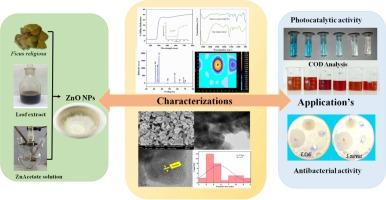利用榕树叶提取物可持续合成具有更强光催化和抗菌活性的氧化锌纳米结构
IF 4.6
3区 材料科学
Q2 MATERIALS SCIENCE, MULTIDISCIPLINARY
引用次数: 0
摘要
本研究提出了一种利用榕树叶提取物合成氧化锌(ZnO)纳米结构(NP)的可扩展方法。高效薄层色谱法证实叶提取物中富含芦丁,芦丁是一种植物成分,在反应过程中起到螯合剂和稳定剂的作用。粉末 X 射线衍射(P-XRD)分析显示出尖锐而强烈的峰值,证明合成的氧化锌氮氧化物具有很高的结晶度,此外,还使用 FULLPROF 和 VESTA 软件对 P-XRD 数据进行了里特维尔德细化,证实氮氧化物属于六方菱面体相。利用场发射扫描电子显微镜(FE-SEM)和能量色散 X 射线分析对合成的 NP 的表面形态进行了研究,结果表明 NP 生长均匀,呈现准球形、球形和六角形结构,纯度高。透射电子显微镜分析证实了 FE-SEM 的结果,并显示 NP 的平均结晶尺寸为 5.72 ± 2 nm。此外,傅立叶变换红外光谱在 516 cm-1 处显示出一个尖锐的峰值,这是 Zn-O 伸展振动引起的。值得注意的是,纳米粒子表现出了卓越的光催化活性;在露天阳光下,100 分钟的时间间隔内,亚甲基蓝(MB)染料的降解率达到了 100%。此外,还评估了 NP 对大肠杆菌(E.coli)和金黄色葡萄球菌(S. aureus)的实质性杀菌特性。因此,本研究强调了树叶提取物作为一种可持续和生态友好型资源在合成 NP 方面的有效性,并强调了其在阳光诱导的染料降解和抗菌剂方面的潜力。本文章由计算机程序翻译,如有差异,请以英文原文为准。

Sustainable synthesis of ZnO nanostructures using Ficus religiosa leaf extract with enhanced photocatalytic and antibacterial activity
This study presents a scalable approach to synthesizing zinc oxide (ZnO) nanostructures (NP’s) by utilizing the leaf extract of Ficus religiosa plant. The high performance thin layer chromatography substantiates leaf’s extract enriched with rutin, a phytoconstituents which played a pivotal role through acting as chelating and stabilizing agent during propagation of reaction. The Powder X-ray diffraction (P-XRD) analysis displayed sharp and intense peaks that corroborate for high crystallinity to the synthesized ZnO NP’s, furthermore the P-XRD data were scrutinized with Rietveld refinement using FULLPROF and VESTA software’s which confirmed NP’s belongs to hexagonal wurtzite phase. The surface morphology of synthesized NP’s was investigated using field emission scanning electron microscopy (FE-SEM) coupled with energy dispersive X-ray analysis, which revealed NP’s grown homogeneously and exhibited quasi-spherical, spherical and hexagonal structure’s with high purity. Transmission electron microscopy analysis endorsed FE-SEM results and shown NP’s have an average crystallite size of 5.72 ± 2 nm. Moreover, Fourier transforms infrared spectroscopy spectrum divulge a sharp peak at 516 cm−1, which was arises due to Zn-O stretching vibration. Remarkably, the NP’s exhibited excellent photocatalytic activity; a complete 100 % degradation of methylene blue (MB) dye was monitored in 100 min of time interval under open air sunlight. Moreover, the substantial bactericidal properties of the NP’s were assessed against Escherichia coli (E.coli) and Staphylococcus aureus (S. aureus). Therefore, this study highlights the effectiveness of leaf extract as a sustainable and eco-friendly resource for NP’s synthesis and emphasizes its potential for sunlight induced degradation of dye as well as antibacterial agent.
求助全文
通过发布文献求助,成功后即可免费获取论文全文。
去求助
来源期刊

Materials Science and Engineering: B
工程技术-材料科学:综合
CiteScore
5.60
自引率
2.80%
发文量
481
审稿时长
3.5 months
期刊介绍:
The journal provides an international medium for the publication of theoretical and experimental studies and reviews related to the electronic, electrochemical, ionic, magnetic, optical, and biosensing properties of solid state materials in bulk, thin film and particulate forms. Papers dealing with synthesis, processing, characterization, structure, physical properties and computational aspects of nano-crystalline, crystalline, amorphous and glassy forms of ceramics, semiconductors, layered insertion compounds, low-dimensional compounds and systems, fast-ion conductors, polymers and dielectrics are viewed as suitable for publication. Articles focused on nano-structured aspects of these advanced solid-state materials will also be considered suitable.
 求助内容:
求助内容: 应助结果提醒方式:
应助结果提醒方式:


